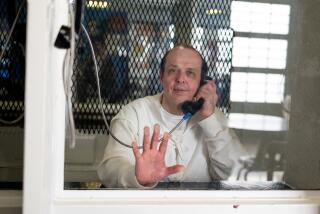‘Walking’ Fuels the Case for Live Executions
- Share via
It’s rare that a theatrical movie helps make a case for a television program, but “Dead Man Walking” does just that.
Well, not exactly a television program. A proposed program. Well, not really a proposed program, either. At this point, merely a concept.
The televising of executions.
Yes, that again.
“Dead Man Walking” not only revisits the issue of capital punishment with care and stunning intensity while deploying Sean Penn on death row and Susan Sarandon in his spiritual corner, but is so meticulously detailed in its staging that it indirectly suggests what an execution telecast could be like. That is, if you envision director Tim Robbins’ lens being a TV camera and exclude his close-ups of a compassionate Sarandon.
No whistles and bells. No marching bands. No beer or popcorn munchies. No breath-by-breath commentary and instant analysis. No “Hard Copy” slugs with their noses pressed against the windows of the execution chamber as if it were a candy store. No taking sides. Just the process of a killer being methodically killed (in this case by lethal injection, with lingering tight shots of cardiac monitors and various intravenous lines) intersected by memorable homages to the victims and testaments to the viciousness of their murders.
To some a moment of deep somberness and even repugnance, to others a long-awaited moment of justice, sweet revenge and celebration.
What it wouldn’t have to be like, despite this decade’s media garishness, is the cheesy spectacle cooked up in NBC’s “Witness to the Execution,” a witlessly hot-wired 1994 movie in which a convicted multiple-slayer’s big burn was set in a mega-dome for live telecast, titled “Countdown to Justice” and packaged like the Super Bowl, with promos, billboards, a pre-show hosted by a priest and a phone poll at $1 a call. You wanted to fry the producers.
TV programs are not always this banal when depicting executions. NBC’s “L.A. Law,” for example, once portrayed a man dying in a gas chamber so vividly that you almost felt you were perched on his lap.
Yet nothing within memory delivered as powerfully as “Dead Man Walking.”
Even if you challenge the hypothesis, you may admire the daring of anyone advocating something as unpopular as televising executions. Phil Donahue raised that banner--wanted to do it himself, in fact, in a responsible way--and took an unfair lambasting from critics who accused him of exploitation. Now he probably won’t get his chance, for his talk show is headed off the air.
Thanks largely to the O.J. Simpson murder trial, these are times when TV cameras everywhere are widely in disrepute, and their exclusion from California courtrooms--which would be a foolish, regressive move driven mostly by emotion rather than reason--seems a distinct possibility.
Yet the logic of televising executions is arguably even more compelling, and can’t be ignored. Just how would cameras in the execution chamber distort or pervert anything? On the contrary, as this column has argued previously, because capital punishment is public policy in this and 37 other states, and paid for with your money, such executions should be public and available via TV--with tight controls. For instance, the condemned person must give permission. And live or not, the telecast must be late at night and give appropriate attention to the crime or crimes that precipitated the execution.
*
Polls indicate that the vast majority of Americans favor capital punishment, and executions are on the rise. But even if only a small segment of that majority cares to watch, society should have the opportunity at least to see and fully appreciate what it endorses, instead of getting only secondhand, sometimes-conflicting accounts from designated witnesses. It’s as simple as that.
The issue is especially pertinent to California, where San Francisco public-TV station KQED was turned down when it wanted to televise the San Quentin execution of Robert Alton Harris in 1992, and where William Kirkpatrick Jr.--convicted slayer of two fast-food workers--is scheduled to die March 28 by lethal injection (San Quentin’s gas chamber was closed in 1994), after getting a two-month postponement to confer about things with his attorneys. And scheduled in two days is the firing squad execution of Albert Taylor in Utah.
Would televising these death rituals be too gruesome for the public, as some suggest? Well, no one would command you to watch. Moreover, how much more gruesome can TV get? Late last year, for example, an episode of the syndicated “L.A.P.D.--the Series” showed a man who committed suicide dangling from the end of a rope in his apartment. That was exploitative.
Opponents of televised executions argue, too, that cameras would transform them into circuses, as if they are now gleaming symbols of taste and decorum, and as if the spirit of Barnum & Bailey weren’t already present in the media hordes that cluster outside and afterward hang on every descriptive word from those who served as official witnesses.
Cards on the table here. Those of us who favor either abolishing or further limiting capital punishment would applaud if the rest of the public found televised executions sufficiently barbaric to rise up and demand a reversal of policy. But that’s not the point, for just as likely, these repetitive telecasts would desensitize most viewers to the process, resulting in no change. Or perhaps their graphic nature would deter potential murderers, and thus bolster arguments in favor of capital punishment and keep dead men walking indefinitely. Who’s to know? In any case, what exactly are we afraid of?
The point is that if executions are an expression of public will, we shouldn’t be ashamed of them. So set up the cameras and switch on the red light.
More to Read
The complete guide to home viewing
Get Screen Gab for everything about the TV shows and streaming movies everyone’s talking about.
You may occasionally receive promotional content from the Los Angeles Times.






